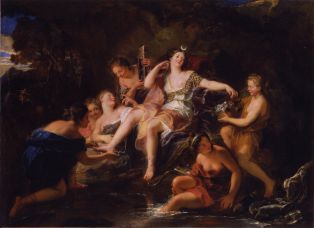- Découvrez les collections
- Notice d'oeuvre





Aller plus loin :
Rouen, 1644 ; Paris, 1717
H. 109 cm ; l. 84 cm (sans cadre)
M0536_L.I.36
Inspiré par "Les Métamorphoses d’Ovide", cette peinture illustre l’épisode où Latone et ses deux enfants, Apollon et Diane, sont repoussés par des paysans alors qu’ils voulaient se rafraîchir au bord d’un étang. Latone invoque la colère de son amant, Zeus, qui change alors les paysans en crapauds. Lors de la « querelle du coloris » qui agite l’Académie autour de la prééminence du dessin ou de la couleur, Jouvenet défend la supériorité de la couleur sur le trait. Dans cette œuvre, on constate toutefois son habileté à concilier l’équilibre et la clarté de l’esprit classique avec le dynamisme du courant baroque. En 1661, Jean Jouvenet s’installe à Paris et intègre l’atelier de Charles Le Brun, premier peintre du roi Louis XIV. Il contribue notamment aux décors de la Chapelle royale et du Grand Trianon à Versailles, à ceux de la galerie des Tuileries et des châteaux de Saint-Germain-en-Laye et de Meudon. Nommé en 1705 directeur de l’Académie royale de peinture et de sculpture, il devient l’un des peintres les plus sollicités de sa génération.
Inspired by Ovid’s Metamorphoses, this painting depicts an episode in which Leto and her two children, Apollo and Diana, are driven away by peasants while attempting to bathe in a pond. Leto invokes the wrath of her lover Zeus, who turns the peasants into toads. In the era the painting was made, debates raged at the Academy over the importance of drawing versus colour, in what was known as the “quarrel over colours”. Jouvenet took the side of colour over lines. However, in this work, one notices the artist’s ability to strike a balance between the clarity of the classical aesthetic and the dynamism of the baroque. In 1661, Jean Jouvenet moved to Paris and began working in the workshop of Charles Le Brun, who was First Painter to King Louis XIV. In particular, he helped decorate the Royal Chapel and the Grand Trianon at Versailles, as well as the gallery in the Tuileries and the castles of Saint-Germain-en-Laye and Meudon. He was named director of the Royal Academy of Painting and Sculpture in 1705, becoming one of the most sought after painters of his generation.
Inspired by Ovid’s Metamorphoses, this painting depicts an episode in which Leto and her two children, Apollo and Diana, are driven away by peasants while attempting to bathe in a pond. Leto invokes the wrath of her lover Zeus, who turns the peasants into toads. In the era the painting was made, debates raged at the Academy over the importance of drawing versus colour, in what was known as the “quarrel over colours”. Jouvenet took the side of colour over lines. However, in this work, one notices the artist’s ability to strike a balance between the clarity of the classical aesthetic and the dynamism of the baroque. In 1661, Jean Jouvenet moved to Paris and began working in the workshop of Charles Le Brun, who was First Painter to King Louis XIV. In particular, he helped decorate the Royal Chapel and the Grand Trianon at Versailles, as well as the gallery in the Tuileries and the castles of Saint-Germain-en-Laye and Meudon. He was named director of the Royal Academy of Painting and Sculpture in 1705, becoming one of the most sought after painters of his generation.
Jupiter a contracté un mariage d’amour avec Junon, déesse du mariage. Malgré cette union, il est connu pour ses infidélités notoires, après lesquelles son épouse exerce sa vengeance contre celles qui ont attiré à leurs dépens l’attention du maître de l’Olympe. C’est le cas pour Latone : après avoir mis au monde, dans des conditions difficiles à cause de la persécution engagée par Junon, les jumeaux Diane et Apollon, fruits de ses amours avec Jupiter, elle est poursuivie par le serpent Python et parvient en Lycie, où se déroule la scène représentée ici.
Jupiter married Juno, the goddess of marriage, out of love. Despite this union, he is known for his notorious infidelities, for which his wife took revenge on those who attracted the attention of the king of Olympus at their cost. One such example is Leto: after giving birth to the twins Diana and Apollo, the fruit of her love affair with Jupiter, in difficult circumstances due to Juno’s persecution, she is pursued by the serpent Python and reaches Lycia, where the scene depicted here takes place.
Jupiter married Juno, the goddess of marriage, out of love. Despite this union, he is known for his notorious infidelities, for which his wife took revenge on those who attracted the attention of the king of Olympus at their cost. One such example is Leto: after giving birth to the twins Diana and Apollo, the fruit of her love affair with Jupiter, in difficult circumstances due to Juno’s persecution, she is pursued by the serpent Python and reaches Lycia, where the scene depicted here takes place.







 Copyright© WebMuseo 2017 - 2024
Copyright© WebMuseo 2017 - 2024